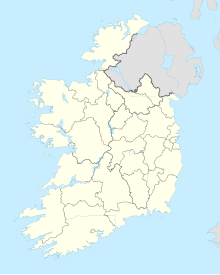Alice and Gwendoline Cave
| Alice and Gwendoline Cave | |
|---|---|
| Uaimh Ailíse agus Gwendoline | |
| Location | Edenvale, Ennis, County Clare |
| OSI/OSNI grid | R 319 745 |
| Coordinates | 52°49′04″N 9°00′34″W / 52.817650°N 9.009355°W |
| Geology | Limestone |
| Entrances | 1 |
The Alice and Gwendoline Cave is a limestone cave in County Clare, Ireland. It is known as the site of brown bear bones bearing the mark of butchery, which have pushed back the first known human habitation of Ireland by over two thousand years.[1][2]
Location

The Alice and Gwendoline Cave is located about 1 kilometre (0.62 mi) southwest of Ennis, near to Edenvale House and Edenvale Lough.[3]
History
Previously called the Bull Paddock Cave, the Alice and Gwendoline Cave was named for two of Alice Julia Stacpoole's daughters, Alice Jane and Gwendoline Clare Surprise, nieces of Thomas Johnson Westropp.[4][5] It was investigated in 1902.[6]
In 2016, a bear
IT Sligo) and Dr Ruth Carden (National Museum of Ireland) were co-discoverers.[9]
References
- JSTOR 30078871.
- ^ Murphy, Anthony. "Mythical Ireland | Blog | The bear bone that pushes back human presence in Ireland by 2,500 years to 10500BC". Mythical Ireland | New light on the ancient past. Archived from the original on 18 January 2021. Retrieved 26 May 2020.
- ^ "Exploration of the Caves of County Clare". Acad. House. 26 May 1906 – via Google Books.
- ^ "This €3.5m period property was home to one of Britain's top radio and TV personalities". Irish Independent. 7 September 2018. Retrieved 2 August 2020.
- ^ "Ann Fitzgerald: The bare bones of history reveal some ancient secrets". Irish Independent. 7 September 2018. Retrieved 2 August 2020.
- ^ Below, Darkness. "Alice and Gwendoline Cave – Darkness Below".
- JSTOR 43816774.
- ^ Dowd, Marion. "A remarkable cave discovery: first evidence for a late Upper Palaeolithic human presence in Ireland". Archaeology Ireland 30 (2), 21-25 – via www.academia.edu.
- ISBN 9783030373672– via Google Books.

